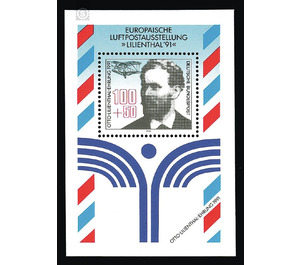100th anniversary - Germany / Federal Republic of Germany 1991
Theme: Post & Philately
| Country | Germany / Federal Republic of Germany |
| Issue Date | 1991 |
| Item Type | Block |
| Chronological Chapter | GER-BRD |
| Chronological Issue Number | Block 24 |
| SID | 433258 |
| In 20 Wishlists | |
A block of Deutsche Bundespost commemorates the anniversary "100 years of the first human flight through Otto Lilienthal" and also points to the European airmail exhibition "Lilienthal '91" in Dresden. Otto Lilienthal, who was born on 23 May 1848, the son of a cloth merchant in Anklam, is undoubtedly one of the great pioneers of aviation. Already in his youth, he spent together with his one and a half years younger brother Gustav hours of his free time in the Karlsburger heath in the observation of storks, gulls, hawks and buzzards and dreamed of rising one day the birds straight into the air. He was just 14 when he built his first "flying machine" - a few wings made of ledges and beech boards. He certainly could not fly, but the age-old wish of mankind to overcome the earth's gravity did not let him go. At the age of eighteen, he graduated from the vocational school in Potsdam, worked as a young engineer in a Berlin machine factory, and later completed his knowledge at the Royal Industrial College in Berlin. After participating in the German-French War of 1870/71 he worked in various companies, constructed a Schräm machine for mining, a stone building kit for children and a special steam boiler, on which he got a first patent. This was the starting point for founding a company of its own, which soon employed up to 60 workers and already knew the profit sharing of employees - long before Zeiss in Jena. Otto Lilienthal always dealt with the flight problem casually, and in the 1980s turned to him even more intensively. In 1889 he summarized the state of his research and findings in a book entitled "The Flight of the Birds as the Basis of Aviation Art - A Contribution to the Systematics of Flight Engineering". The author concluded this work with the prophetic words: "But nevertheless we must hold it possible that the research and the experience, which is in line with experience, bring us nearer to the great moment when the first free-flying man, even if only for seconds, rising from the earth with the help of wings, and bringing about the historical moment which we must call the beginning of a new cultural epoch. " Lilienthal had laid the theoretical foundations of gliding with this book. After that he went to the practical realization. To do this, he built the first flying machines made of willow wood frames and shirting, a cotton fabric covered with paint, and tried to work his way up to his destination "from the step to the jump, from the jump to the flight". In the summer of 1891 he moved to his first "airfield" on the Mühlenberg near Derwitz and performed there in August 100 years ago, the first human flight of initially about 15 meters wide. "The day on which Lilienthal made his first fifteen meters in the air in 1891, I take as the moment since people can fly." So wrote the French aviation pioneer Ferdinand Ferber (1862 - 1909), and has the historiography of flying joined. Otto Lilienthal had countless others to follow the »pioneer air leap«. He built a total of more than 20 different aircraft - single and double decker - found on Gollenberg at Stölln in the Rhinow mountains between Neustadt an der Dosse and Rathenow since 1893 his main training ground and soon reached flight distances up to 300 meters. International experts became aware, and Lilienthal's theoretical and practical work promoted the work of many other aviation pioneers. In the summer of 1896 Lilienthal drove the last time in the Rhinow mountains, on August 9, he crashed from 15 to 20 meters altitude so unhappy that he died the following day in Berlin on a spinal injury. To commemorate this man and his accomplishments is also the concern of the European airmail exhibition "Lilienthal '91" from 16 to 25 August 1991 in Dresden. It promises to be a culmination of the aerophilatelie and is substantially funded by the Foundation for the Promotion of Philately and Postal History, which receives the proceeds of the new Lilienthal block.


